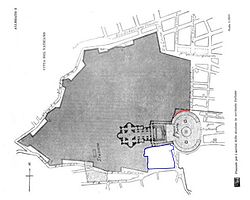Lateran Treaty
| State of Vatican City |
 This article is part of the series: |
|
|
|
|
Other countries · Atlas |
The Lateran Treaty is one of the Lateran Pacts of 1929 or Lateran Accords, three agreements made in 1929 between the Kingdom of Italy and the Holy See, ratified June 7, 1929, ending the "Roman Question".
They consisted of three documents:
- A political treaty recognizing the full sovereignty of the Holy See in the State of Vatican City, which was thereby established.
- A concordat regulating the position of the Catholic Church and the Catholic religion in the Italian state.
- A financial convention agreed on as a definitive settlement of the claims of the Holy See following the losses of its territories and property.
Contents |
History

Negotiations for the settlement of the Roman Question began in 1926 between the government of Italy and the Holy See, and culminated in the agreements of the three Lateran Accords, signed for King Victor Emmanuel III of Italy by Prime Minister Benito Mussolini and for Pope Pius XI by Cardinal Secretary of State Pietro Gasparri on February 11, 1929. The agreements were signed in the Lateran Palace, hence the name by which they are known.
The agreements included a political treaty which created the state of the Vatican City and guaranteed full and independent sovereignty to the Holy See. The Pope was pledged to perpetual neutrality in international relations and to abstention from mediation in a controversy unless specifically requested by all parties. The concordat established Catholicism as the religion of Italy. The financial agreement was accepted as settlement of all the claims of the Holy See against Italy arising from the loss of temporal power in 1870.

The sum thereby given to the Holy See was actually less than Italy declared it would pay under the terms of the Law of Guarantees of 1871, by which the Italian government guaranteed to Pope Pius IX and his successors the use of, but not sovereignty over, the Vatican and Lateran Palaces and a yearly income of 3,250,000 lire as indemnity for the loss of sovereignty and territory. The Holy See, on the grounds of the need for clearly manifested independence from any political power in its exercise of spiritual jurisdiction, had refused to accept the settlement offered in 1871, and the Popes thereafter until the signing of the Lateran Treaty considered themselves prisoners in the Vatican, a small, limited area inside Rome.
To commemorate the successful conclusion of the negotiations, Mussolini commissioned the Via della Conciliazione (Road of the Conciliation), which would symbolically link the Vatican City to the heart of Rome.
The Lateran Agreements were incorporated into the Constitution of the Italian Republic in 1947.
In 1984 an agreement was signed, revising the concordat. Among other things, it ended the Church's position as the state-supported religion of Italy, replacing the state financing with a personal income tax called the otto per mille.
In 2008, it was announced that the Vatican would no longer immediately adopt all Italian laws, citing conflict over right-to-life issues.[1]
Violations
Italy's anti-Jewish laws of 1938 prohibited marriages between Jews and non-Jews, including Catholics. The Vatican viewed this as a violation of the Concordat, which gave the church the sole right to regulate marriages involving Catholics.[2] Article 34 of the Concordat also had specified that marriages performed by the Catholic Church would always be considered valid by civil authorities.[3] The Vatican understood this to include Matrimony between non-Aryan Catholics or between one Aryan and a non-Aryan.[3]
In February 1944, the Basilica of Saint Paul Outside the Walls, one of the enumerated extraterritorial properties of the Holy See, was attacked by bands of Fascists of Italian Social Republic (RSI).[4]
See also
- Holy See
- Vatican City
- Prisoner in the Vatican
- Properties of the Holy See
- Concordat with Germany
References
Bibliography
- Riccards, Michael (1998). Vicars of Christ: Popes, Power, and Politics in the Modern World. New York: Crossroad. ISBN 082451694X.
- Zuccotti, Susan (2002). Under His Very Windows: The Vatican and the Holocaust in Italy. New Haven: Yale University Press. ISBN 0300093101.
Notes
- ↑ Elgood, Giles (2008-12-31). "Vatican ends automatic adoption of Italian law". Reuters. http://www.reuters.com/article/worldNews/idUSTRE4BU3BD20081231. Retrieved 2009-01-09. "The Vatican will no longer automatically adopt new Italian laws as its own, a top Vatican official said, citing the vast number of laws Italy churns out, many of which are in odds with Catholic doctrine."
- ↑ Zuccotti, 2000, p. 37.
- ↑ 3.0 3.1 Zuccotti, 2000, p. 48.
- ↑ Riccards, 1998, p. 141.